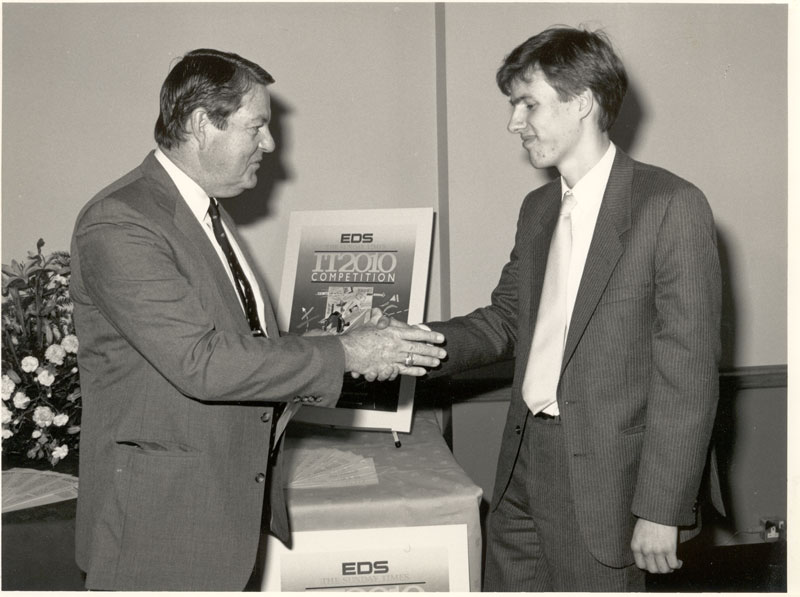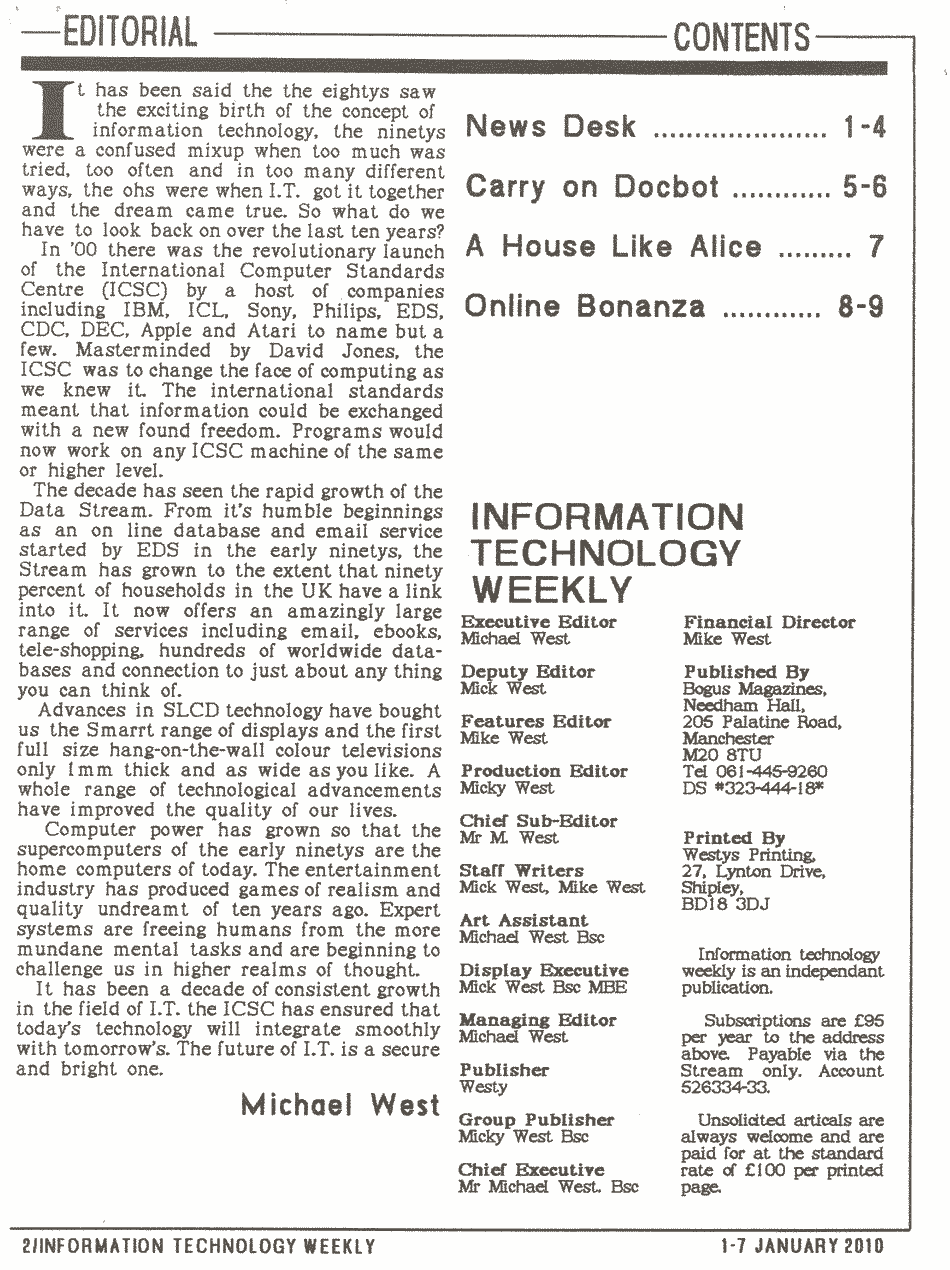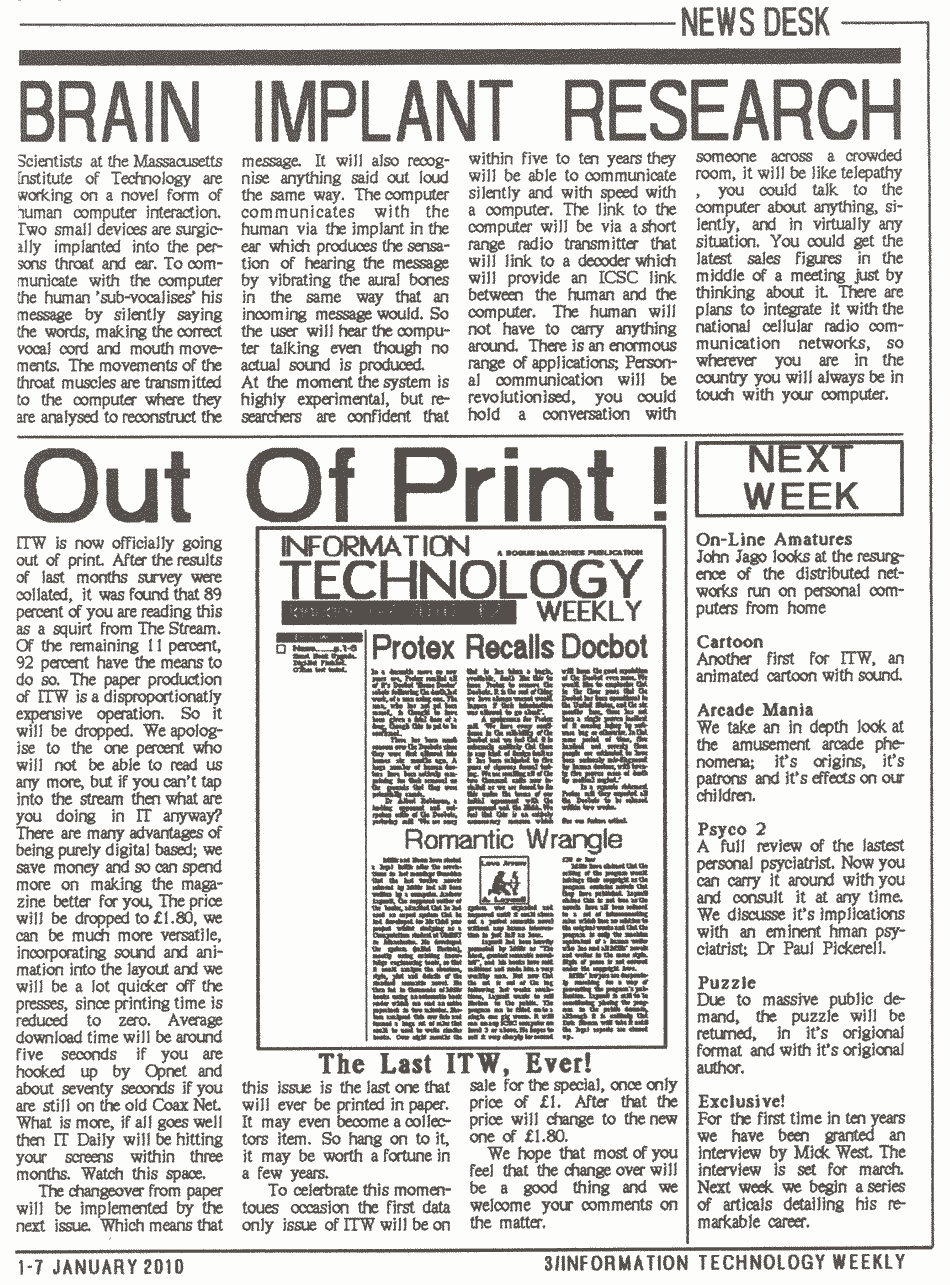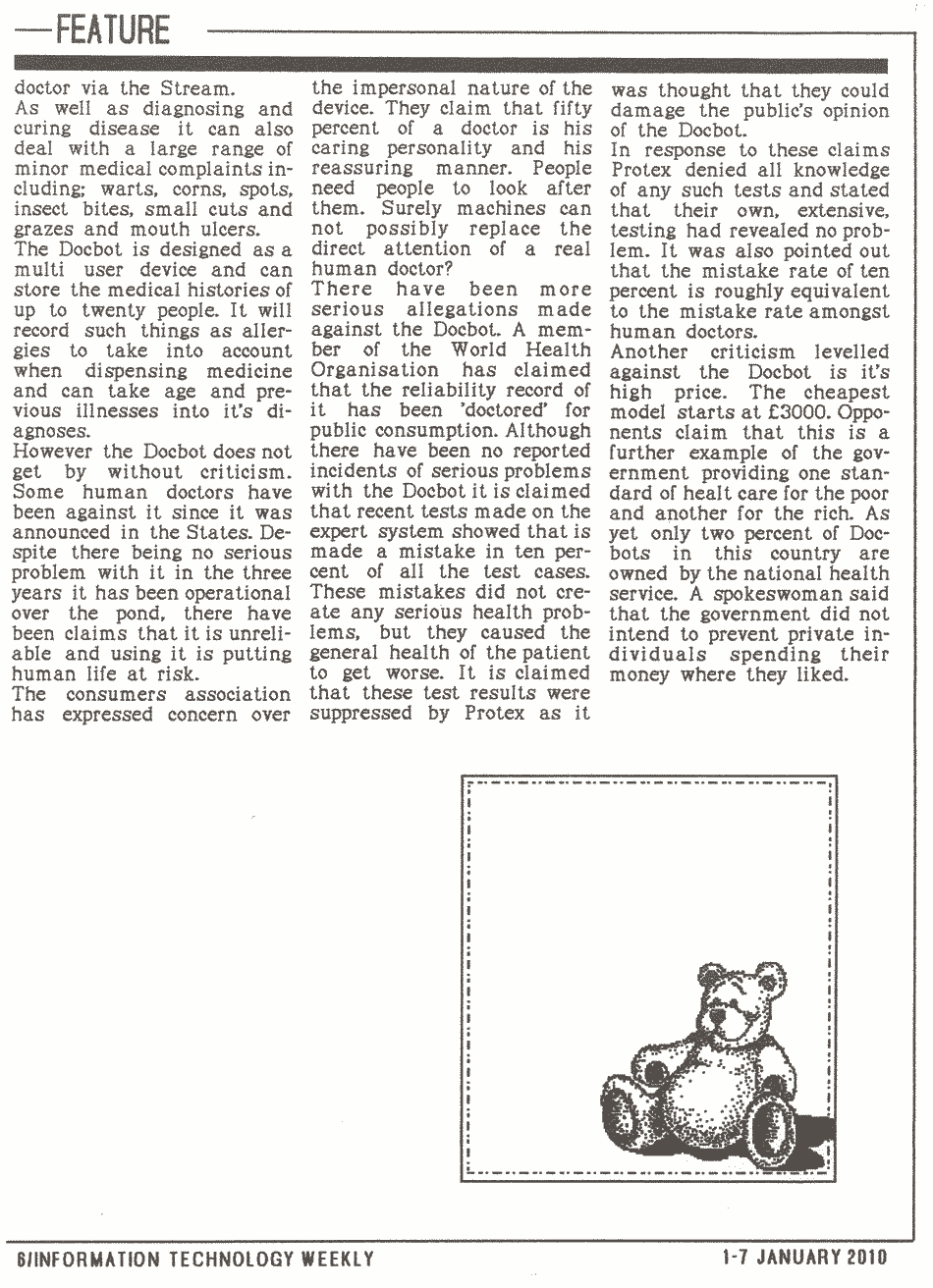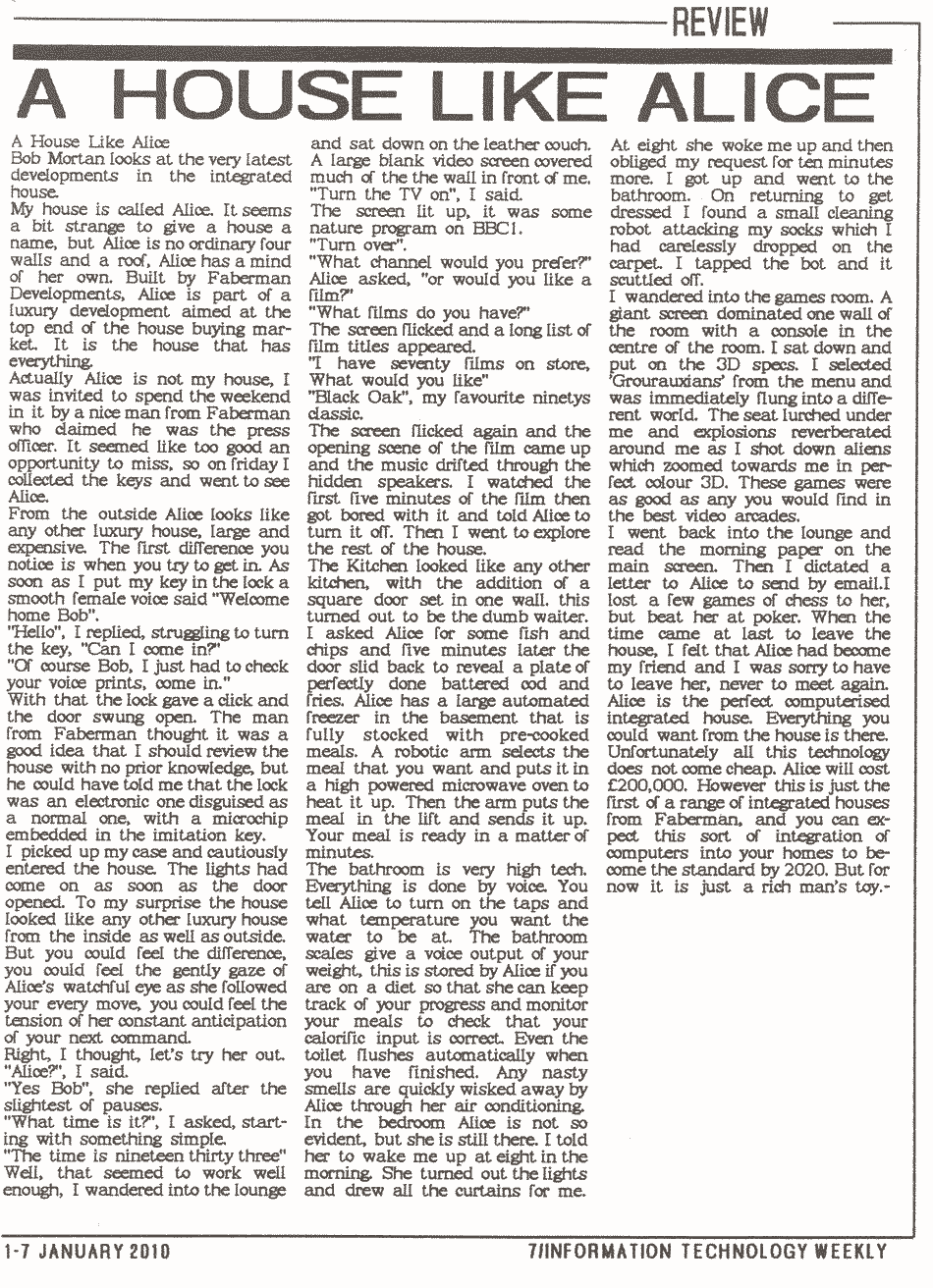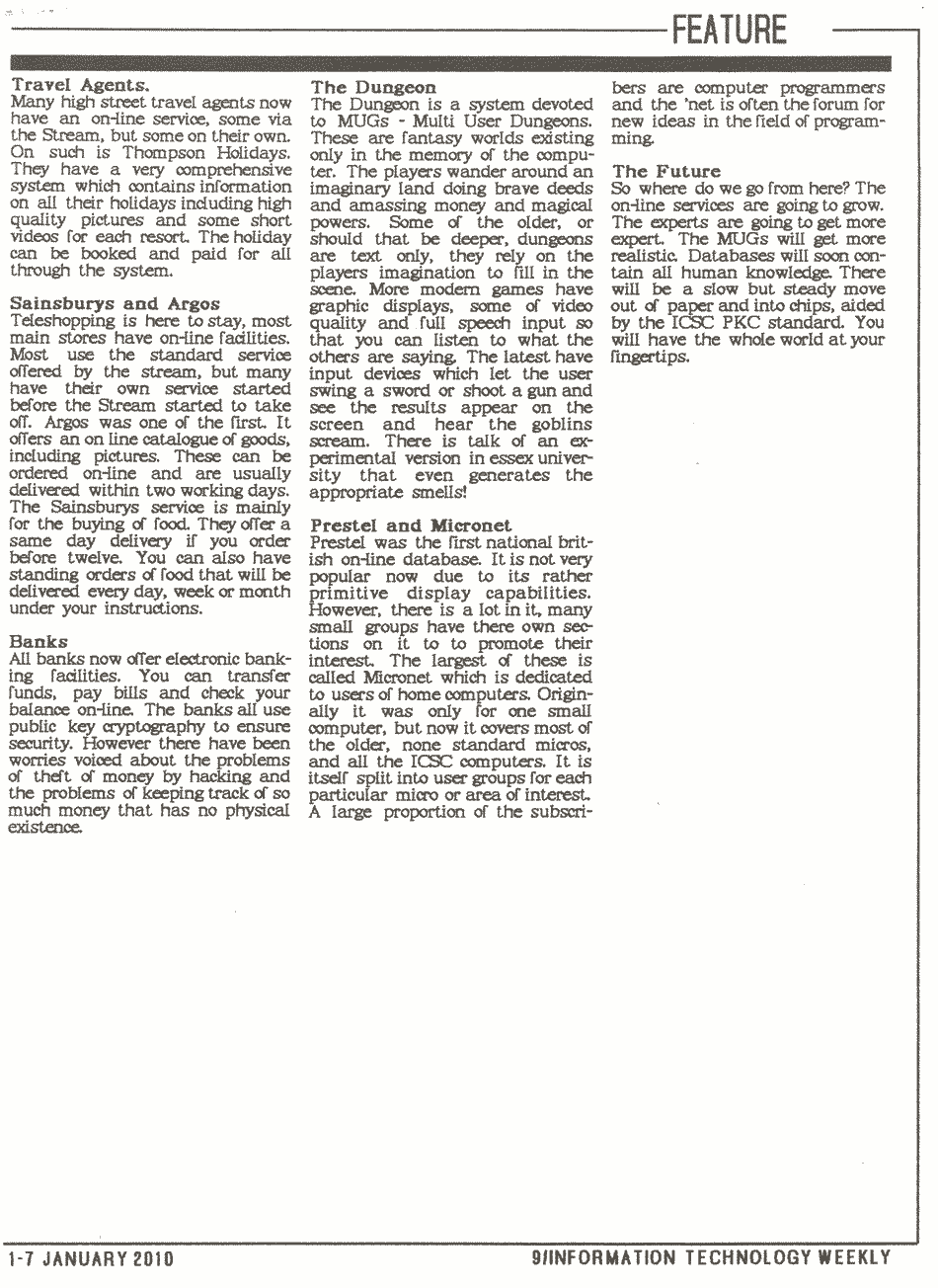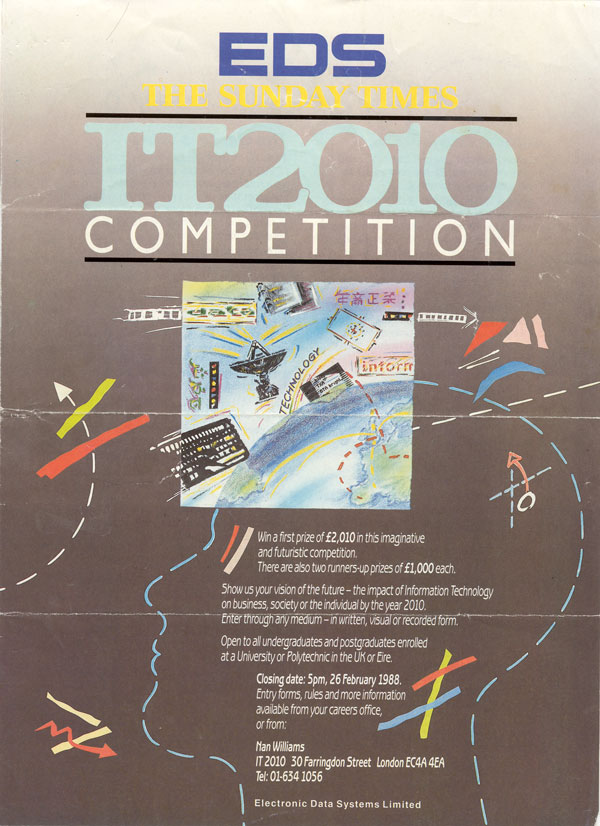
IT2010 was a competition I entered and won in early 1988. At that time I was 20 years old and a student at the University of Manchester Institute of Science and Technology (more commonly known as UMIST). The competition was a join promotion on the part of EDS (a large IT company, previously part of GM), and the Sunday Times (a venerable British Newspaper).
The competition was only open to students currently in higher education, and basically involved predicting what “Information
Technology” would look like in the year 2010, which would be 22 years in the future back then. The prize was £2010, which would be the equivalent of around $8000 in today’s money, a staggeringly large amount of money for a poor student back then, greater than all the money I had spent in my entire life up to that point. So I resolved to enter.
I gave the matter much though, but little actual work, and a week before the deadline I had practically nothing written. I steeled myself, and basically skipped class for the rest of the week, staying up late each night to get the thing done. I was using rather archaic equipment. An Atari ST (a 16Mhz Atari 520STFM, with 1MB of RAM, and no hard drive), and a copy of “Fleet Street Publisher” (a “Desktop Publishing” program), and an Epson printer (a 9-Pin Dot Matrix printer, maybe the Star LC-10).
To give you some more perspective, in early 1988 the World Wide Web had not even been invented. There were NO web servers on the internet. Hard drives were being sold with 20MB of space for $500. (Now you can get 200000MB for $200). CD-ROM was invented in 1985, although I’d never heard of it. All software was distributed on floppy disks. Only academic types had email. I did not have e-mail at university.
I completed my entry, and mailed it in just a few days ahead of the deadline of Feb 26th, 1988. A little over a month later, shortly after my 21st Birthday, I received notice that I had won. I traveled down to London in May for the award ceremony, where I discovered there were only about 250 entries, which stymied my pride somewhat. But I still got the money! This proved be a pivotal point in my life, as the money allowed me to not get a job for a few months, while I played around with my Atari writing game programs, and eventually got a job in the games industry, where I was quite successful. Had I lost the competition I would have had to go back to living with my Mum in Shipley, leading to a quite different direction in my life.
Now, not far off 2010, I was looking back on the predictions I made, and found that many of them had come to pass as I foretold. Many were also off the mark, but it’s interesting how I viewed the future back then, and the ways in which the present differs from my predictions.
The Predictions:
Page 1
(All page thumbnails here link to the full sized page, exactly as I submitted it for the competition)
The layout of IT Weekly was based on a British magazine “Popular Computing Weekly”. I followed the layout of the front page and first pages very closely, and then created templates for the other pages. This gave the work a bit more of a professional look, which probably helped a bit.
“Protex Recalls Docbot” – related to a story inside, basically intended to convey the spirit of the times, with computers beginning to encroach on tasks that most people assumed would only ever be carried out by humans, and the associated resistance of society to this. Here we have a robotic doctor, and the resistance is indicated by excessive government regulation causing the robot to be recalled for relatively minor fears.. Funnily I indicated the the “Docbot” is operating in the USA, which would be rather unlikely due to the overly litigious nature of the US, and the fear this instills in large medical corporations.
“Romantic Wrangle” – Natural Language Database, Romance Novel Generation, copyright issues – I’d imagined that around this time, computers would be powerful enough to write simplistic literature, such as romance novels. It seemed likely that there would be some confusion arising from who wrote a novel if they were assisted by a machine, and people would feel the value of a novel would be diminished if it were “machine made”. This has not come to pass, but I don’t feel it’s far off, and it’s a field of research I am particularly interested in.
Also mentioned is distributing a program on a “one gig worm“, (WORM = Write once, Read Many), essentially a CD-ROM, which is a prediction that came to pass many years ago, and is by now heading for obsolescence. By 2010, most software will be distributed via the internet.
Here we have the first mention of ICSC computers, see more on this later.
The story relates to the current upheaval regarding intellectual property as we transition to digital distribution. The old publishing house (Mills and Boon), is concerned that it will go out of business due to an influx of cheap works that are essentially derived from it’s intellectual property (shades also of SCO/Linux?). The author of the book writing software is attempting to place the software in the public domain, but the “Data Stream” will not take it for legal reasons. The “Data Stream” is the internet, but I mistakenly forecast it as a single commercial entity.
Page 2 – Editorial, Contents, Credits.
The editorial was intended as an easy way to set the scene by rattling off a list of technologies that were current as well as giving a mini overview of the last 20 years.
I like “[regarding IT] .. the nineties were a confused mix-up when too much was tried too often and in too many different ways” – which nicely forecasts the enthusiasm and chaos of the late nineties dot-com boom.
ICSC – International Computer Standards Center. A supposed world standard for personal computers. In 1988, the “IBM PC” (or just “PC”) had yet to achieve the ubiquity it now enjoys, and we were faced with a variety of incompatible home computers such as the Atari ST and Commodore Amiga, which were both much more popular than the PC in the UK. The closest thing we have in 2004 to an ICSC computer is a PC running Microsoft Windows. Apple is currently a minor factor. Perhaps by 2010, a Linux Box will be a closer equivalent to an ICSC computer.
The “Data Stream” – Basically my prediction of the widespread adoption of the internet, see a fuller article on this later.
“Hundreds of worldwide databases” – I think I was referring to on-line reference databases here, like dictionaries and encyclopedias.
Flat Screens – “full size hang-on-the-wall color televisions only 1mm thick and as wide as you like“. My TV now is 3 inches thick (75mm), so we’ve a way to go.
Video Games – “games of realism and quality undreamt of ten years ago“, games have come a long way, and they are not going to stop here. I don’t know if I was even thinking of games like DoomII, but I don’t think I would have been disappointed by the current state of games.
AI – “Expert Systems are freeing Humans from the more mundane tasks, and beginning to challenge us in higher realms of
thought.” – I think people have got tired of the promise of AI as a panacea for all our problems, and the problems have gradually become more refined, allowing themselves more targeted solutions, and the issue of what is or is not AI is irrelevant. AI in the sense of complex decision making systems is here. AI in the sense of a machine you can have a conversation with has shown itself to be a separate problem. Where I then wrote “Expert Systems are freeing humans from the more mundane tasks“, we would now write “computers are now an integral part of our work environment”, for now that computers have arrived, we quickly forget that those tasks (finding a cheap airline ticket, researching without books, contacting twenty friends simultaneously) ever existed as problems to be freed from.
On-line payments “Payable by the Stream only, Account 526334-33” – Anticipating PayPal.
Notably absent on the front page is any web or email addresses, instead there is a “Data Stream” Number DS #323-444-18* – I would have been influenced by “CompuServe”, a dial-up service, and later ISP, which for a long time only provided a number for email communication (much like ICQ does).
“Brain Implant” – A communication system where an implant in the throat (not the brain, that was just fake journalistic exaggeration), picks up vibrations for transmission of voice, and an implant in the ear allows silent audio. I’m sure I got this from some Science Fiction story, but it might have been a book. Anyway, not my idea, I just though it would eventually happen. Curiously there was a Slashdot story on something similar recently referencing a Yahoo News Story
“Out of Print” – Print publications shifting from paper to on-line publishing. A couple of years ago (in 2002 ish), I read a similar story in a video game trade publication (CTW, now no longer published even on the internet). They even had a picture of it’s front page reproduced in miniature, just like in my story.
“Distributed networks run on personal computers from home” – I think here I was referring to things like “FIDO”, which was originally a dial-in system of BBSs which distributed data by phoning each other up automatically overnight. I did not really have a clear idea how these would be resurging in 2010, but systems such as “freenet” come to mind. The “distributed” part also suggests distributed.net, but I’m really not sure what I was thinking.
“An animated cartoon with Sound” – Basically a flash cartoon, of which there are a lot now.
“Arcade Mania” – Not particularly revolutionary, as arcades existed back in 1988. It’s interesting that they STILL exist though. Again I’m not sure what I was thinking, probably just a filler spot.
“Psyco 2” … “the latest personal psychiatrist” – inspired by “Eliza“.
Now we have lots of “chatterbots”, but I don’t know if people are replacing their shrinks with them. People probably prefer a real person, and since there are lots of anonymous people on the internet, why use a robot. My thinking was constrained by thinking of the “Data Stream” (internet) as not being “always on”, and thinking more in terms of traditional software distribution.
“Puzzle” – This was a joke. The magazine on which IT Weekly was based was “Popular Computing Weekly”, and had a
weekly Puzzle page, which was scrapped, and then re-instated due to popular demand.
Exclusive interview with Mick West – A prediction that still has a few years to pan out :)
“Cheap Atari Laser Printer” – Atari was a viable company back then, and they made personal computer and packaged things like hard drives and printers. Now it’s just a trademark owned by Interplay, how sad. This article seems rather boring, but I like it as shortly after I wrote it, a friend of mine (Steve Edge), said “I like it, but I don’t understand why you made the laser printers with such low specifications”. I think he was expecting 1000 Pages per minute, and and 2400 dpi, or something outlandish. Instead, I was forecasting 600 dpi, 30 ppm black and white for £1100 (around $2000). with color for £1500 ($2900). My thinking back then was that a laser printer was a mechanical device, and as such was much more constrained by the laws of physics than computer chips, and so would not improve much over the years. Now in 2004, for $2000 you can get at HP LaserJet 4200dth black and white printer at 1200 dpi, and 35ppm. Not significantly different from my projection. We still have six years to go, but I don’t see much change. I think people tend to project progress of everything at a similar rate, when computers are progressed about 20000 fold, in the time printers have only improved five fold.
“Pocket Amstrad Minim” – Amstrad were the makers of cheap PCs back in 1988. They had released a “portable” PC
called the “Sugar”, at 12 pounds it was a PC with no hard drive, just a 720K 3.5″ floppy, 512K of RAM, 8Mhz 8086 processor and a 640×200 monochrome display. for ~$700. Quite attractive back then. My prediction was for a $300 device, 16MB Ram, with a very small form factor. Basically something like a modern PDA or about one year ago, so I was underestimating here, but I don’t feel I was too far off the mark, as what I was describing did not exist in any way back in 1988 (the closest thing was the Psion Organiser)
“New Education Computer Plan” – Predicted a computer for every child, something we are approaching (See “One Laptop per Child“, though not relaly the same thing). But also predicted some AI teaching the students. Not really there yet, but I still think that’s on track for 2010. “Steven Johnson” was a friend of mine at Needham Hall. I remember him being very impressed when I won the £2010
“Smarrt Sheet” – A flexible display. This has come to pass with “Polymer Vision”, and is well on track for 2010. “Smarrt” is being used as a trademark by Sonus Networks. eBooks are another current implementation of this, eInk
is finally set to release a paperback sized eBook with contrast the same as newsprint.
This was the longest article and probably the most speculative. Basically forecasting a robot doctor would be
coming into operation in 2010, and meeting with lots of opposition and legal problems.
The “Docbot” here was really just a sophisticated monitoring system which connected to the hospital computer, but it can
also take blood samples, dispense drugs and give injections. Taken as a whole, it’s rather silly (it’s not going to keep a full
pharmacy inside) and generally not too cost effective. A few of the things mentioned are of note though:
“Standard disabled persons i/o devices through the ICSC connecter” – heralding the USB interface, which is what any “disabled person’s i/o device” would use now. Back in 1988 you’d just have RS232.
“Voice input” – Not really interesting, not common now, but
increasingly so. Obvious really.
The home of the future, basically a whole bunch of ideas all thrown together. It was intended to be a demonstration of the “cutting edge” of home technology in 2010. Much of it already exists.
“voice prints” to unlock the door – really not destined to be a popular technology, as someone could just record your
voice. But indicative of trend towards biometrics. There’s
various companies working on voice recognition, but personally I don’t expect anyone to secure their house with it.
“the lock was an electronic one disguised as a normal one with a microchip embedded in the imitation key” – This is very
common now in the automotive industry, and probably in higher security establishments. Home door locks have not changed much though, and they don’t really need to, as lock-picking is not a common method of entry, and if it were, you don’t need to go electronic to make a lock more secure (just use a circular key).
“the gentle gaze of Alice’s watchful eye” – the central computer in the house (Alice) uses computer vision to watch the
occupants to anticipate their needs. Not a common thing now, but some home automation systems will track which rooms you are in for adjusting lighting and heating. Typically it will just use a simple sensor though.
“Turn the TV on” – voice interface throughout the house. Already starting to become common in cars.
Economy of scale will translate this into home use within a few years. See this
“I have seventy films on store” – already people have things like DVD jukeboxes, and the Media PC is becoming more and more common. People will have their home entertainment integrated. It seems more likely now that by 2010, people
will be watching movies over the internet, rather than owning a physical copy.
“a large automated freezer fully socked with pre-cooked meals. A robotic arm … puts it in a high powered microwave oven” – rather silly, possible, but unlikely to become mainstream.
Bathroom scales are integrated with the central computer – this indicated a ubiquity of communication between household
devices. We are moving towards this, although it’s unclear if it will be reached by 2010.
“the toilet flushes automatically when you are finished” – I don’t think I’d seen this happen in 1988, but it’s very common in large public restrooms now.
“In the bedroom Alice is not so evident” – who wants the computer watching them in bed?
“She turned on the light and drew the curtains for me” – this kind of thing has been available for years, but it’s not common, probably because there is no pressing need for it, and a significant hassle factor setting it up, so it’s relegated to rich people, who can pay other people to handle the hassle for them.
“a small cleaning robot” – See Roomba, we’ll probably have lots more like this by 2010.
“3D Specs” for the video games. Quite plausible, just no real market for them. The video games now are already “perfect color 3D”.
“read the morning paper on the main screen” – again, the transition from print to on-line. Although people are more likely to read CNN.com than read a version of a newspaper.
“dictated a letter to Alice to send by email” – not yet you don’t. You can do this now, but it’s easier to type. Voice recognition is still too error prone, and needs some AI to work well with words in context.
“lost a few games of chess to her, but beat her at poker” – Indicating that computers will surpass humans at
computationally intensive games like chess, but we can still beat them at psychological games involving chance, like poker.
“£200,000 – a rich man’s toy” – The price might be off, but total home automation will probably still be rich man’s toy for a while yet. There is simply no pressing need for such a level of automation. Some parts will trickle down, like the robot vacuum, and the collection of movies.
Pages 8 and 9 – Online Bonanza
My vision of the internet, which I called “The Stream”. Not a bad prediction overall. Notable for the prediction of Public Key Infrastructure (used by SSL), and “Trusted Computing”, but has several other accurate predictions:
“90% of households in the UK can access some kind of on-line service” – I never really predicted the homogeneity of the ” Internet”, thinking instead that there would be competing services. Although this is true
in that we have AOL, MSN and Earthlink all with added content, they are really all just ISPs, and most of what you get, you can get from any of them. In 2004, internet penetration is 42% in the UK. It was probably <1% in 1988. Probably will not get to 90% by 2010 though.
“Its main use is as an electronic mail service” – while email is certainly a major usage, it does not really qualify as the “main use”.
“150 million messages every day” – now that’s a pathetic figure, unless it’s just for the UK. The correct number will probably be more like 150 billion by 2010. IDC Research is predicting 36 billion for 2005.
“public key cryptography” – Now this is something that I feel somewhat satisfied in predicting. PKI is very common now, used in all secure internet transaction, especially banking. However I predicted it more for e-mail, and that never panned out. 99% of all email is insecure.
“a key which is unique to your machine” – a part of the Trusted Computing, basically hardware based anti-piracy measures,
marketed as some kind of anti-virus measure. When I described this, I though of it as a good thing, and it certainly has many good aspects (allowing developers to monetize their software), but also raises long-term questions about the freedom to disseminate
information, and who controls the means of distribution.
“The databases – bus and train timetables, email and phone directories, yellow pages” – all of which we have on the internet, but not really as organized as I suggested “all lumped together under a tree structure”, it’s all different databases, although I suppose you could view the “tree structure” as the directory organization of Yahoo, in which case I was right :).
“The software will only run on your machine” – although not using trusted computing, this is already here in software that uses a signature of your machine (usually including the MAC address or the Hard drive serial number) to tie a piece of software to one
machine.
“dictionaries and encyclopedias .. download any article for printing” – this illustrates a failure to anticipate the ease of use that a high speed internet would bring. You don’t need to “download” the article, it’s already downloaded (in a fraction of a second), you just hit “print”.
“news … available by subscription” – very few people pay for their news from the web. It’s pretty much all advertising supported. Something I failed to anticipate. Certainly nobody is using the “ICSC PKC chip” for content protection, although it’s possible that “Trusted Computing” might make this feasible.
“public domain software” – lots of this right now. An easy prediction, but back in 1988 shareware was distributed on a floppy, often on the cover of a magazine.
“Experts” – people don’t really interact with a machine in the way this suggests, although there are some, I don’t think this kind of thing is popular.
“The Law Resource” – See FindLaw, not exactly the same, more of searchable resource than an “expert”, but Search Engines are the new experts, and people often think of Asking” a search engine a question. (I failed to predict web spiders like Google).
“A DHSS form filler” – a joke, inspired by the complexity of the forms for the British Department of Health and Social Services” (now just DSS). In the USA, much more complex forms are found in the tax system, and a whole host of on-line expert systems help you fill them in, like TurboTax, which fills in forms for me that I really don’t want to have to deal with by hand.
“Travel Agents” – See Expedia – I had anticipated that individual travel agents would set up their own “on-line service” (web site), but not that the industry would be transformed, and traditional travel agents would nearly vanish.
“Sainsburys and Argos” – On-line shopping. Obviously something that came to pass, and much more sophisticated than I predicted “Argos … offers and on-line catalogue including pictures” woo woo!
“Banks” – Oh yes, and “you can transfer funds, pay bills and check your balance on-line”, and “the banks all use public key cryptography”, which they do, using SSL.
“The Dungeon” – See Everquest, and others. “full speech input” is still on the drawing board though. Certainly coming soon.
“Prestel and Micronet” – Prestel, a TV/modem tele-text system, died very soon after I wrote this. It was too stuck in the past with 1200/75 modems, and lack of content. However a french system Minitel, succeeded very well. Micronet was a part of Prestel devoted to home computers, and accessing
Prestel via home computers. You could even buy software on it. It could have been the British
internet… But it just died, due to lack of money, and being crap. So it never became the success I predicted. Oh well, can’t win ’em all.
